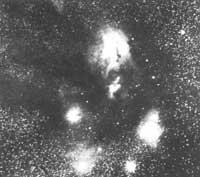Brown dwarfs: dark stars
1989/02/01 Arregi Bengoa, Jesus Iturria: Elhuyar aldizkaria
However, when we talk about giant planets like Jupiter, we have to change our model. These planets do not have a rigid surface like that of the terrestrial planets, and the list of main components is totally different.
As in the case of stars, they consist mainly of hydrogen and helium. Following this path, we could think that the distinctives that characterize the stars and the giant planets were in a difference of size, so we should try to analyze the problem of the border between these stars. This is the topic we will discuss in this article.
The boundary between the stars and the planets mentioned above is occupied by objects called brown dwarf stars. As we will see when analyzing its evolution, in the nucleus there is never enough temperature to produce thermonuclear reactions. Therefore, even if we call it a star, if necessary, we should consider it a weed.

As is known, stars are a consequence of the contraction of clouds formed by interstellar gas and dust, spread over space. This contraction caused by the force of gravity causes it to occur as a protostar with greater internal energy and temperature. If the conversion to the internal energy of gravity is large enough, the temperature in the center of the star will be high enough for the processes that will transform the hydrogen into helium to begin, and then we say that the protostar becomes a star.
The transformation of gravity energy into internal energy depends on the shrinkage process and therefore on the mass of the cloud. Consequently, the problem of the border between stars and planets lies in the determination of the minimum mass necessary for thermonuclear reactions to occur. This critical value is considered slightly lower than one-tenth of the mass of the Sun (0.08 M 0). It is clear, then, that brown dwarfs, with a mass around that value, are objects that do not evolve from the protostar situation to the star.
However, although it may seem otherwise, protostars (and brown dwarfs that will not become stars) have a period of great clarity. When the first contraction starts, the cloud is transparent to radiation. Therefore, we see the light emitted by all the volume. In the case of the common star, the inner layers are opaque and it comes to us only that emitted by the surface. Therefore, the protostar luminosity (and brown dwarfs) can be in this initial period a dozen times greater than that of a sun-like star.
However, very few objects are found and seen at this stage. The reason is in the brevity of a period of great clarity, since in the most common cases it is only about ten million years.
This duration is a thousand times shorter than the life of a sun-like star. Therefore, we can only expect to find a luminous protostar for every thousand normal stars we see in kneading. Some of them will become stars, while others remain brown dwarfs. In the latter case, the nucleus does not generate energy that resists gravity and the contraction will continue until matter reaches a degenerate state of very high density.
In this process, of course, the nano loses transparency, and as the emitting layer or surface is so small, the luminosity becomes ten or one hundred thousandths of that of the Sun. Of course, the brown dwarf will be invisible unless it is very close. In addition, according to theoretical studies, the highest emission intensity is in the field of infrared. Consequently, the absorption of the atmosphere is also greater, making detection difficult.
However, a star is currently known to have a brown dwarf around it and astrophysicists are studying in depth. The white nano G29-38B is capable of doing so. The spectrum of this type of stars is quite well known and, when compared to that of the aforementioned case, an obvious difference can be seen in the infrared field: The emission of the G29-38B is much more intense than that of the model. The increase, it is believed, would be introduced by a star that would be very close to the white nano and emitted in the infrared. As a culmination to the description of the nature of these scrubs we will give a new detail. Different research gives different minimum limits to consider an object as a brown dwarf. Usually, the value is around 0.02 M 0. Therefore, the planet Jupiter, which also has infrared emission, is not entirely different from a brown dwarf, and we could consider it somehow as a brown dwarf.
In addition to the importance of the study of brown dwarfs to know the evolution of stars, the study also has cosmological interest. As we have said, brown dwarfs are very difficult to see. Therefore, to date they have not been taken into account when calculating the density of the Universe, but their contribution can be of great importance.

Gai honi buruzko eduki gehiago
Elhuyarrek garatutako teknologia





